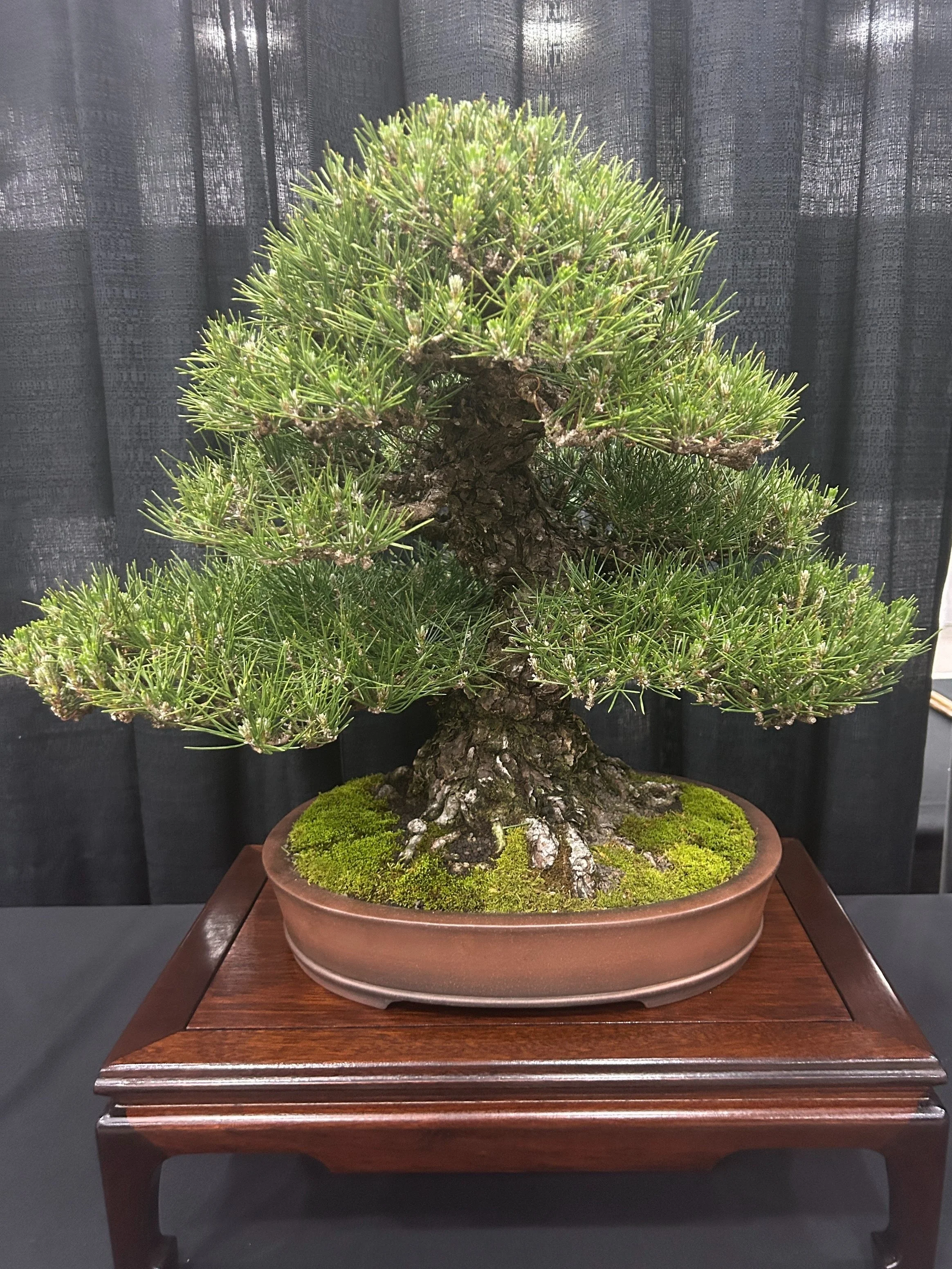JAPANESE BLACK PINE (Pinus thunbergii)
The Japanese black pine (Pinus thunbergii) is a cornerstone species in bonsai, prized for its rugged bark, strong structure, and adaptability to various styles. Its beauty lies in its dense foliage, dynamic branching, and ability to be trained into dramatic forms. Proper care, especially seasonal adjustments and the technique of decandling, is critical for its health and aesthetic refinement.
General Care Overview:
Light: Requires full sunlight for at least 6 hours daily to promote compact needle growth and strong health.
Watering: Allow the soil to dry slightly between waterings. Avoid constantly soggy soil, as Japanese black pines are drought-tolerant but susceptible to root rot.
Soil: Use a well-draining bonsai soil mix, such as akadama, pumice, and lava rock in a 1:1:1 ratio.
Fertilizer: Feed regularly with a balanced bonsai fertilizer during the growing season, reducing in late summer and stopping in winter.
Pruning: Prune to maintain shape and encourage ramification. The timing of pruning and decandling is crucial for proper growth.
Repotting: Repot every 2-4 years in early spring before buds swell, depending on the tree's age and health.
Spring Care (March to May):
Repotting: Early spring is the ideal time to repot your Japanese black pine, as candles begin to elongate. Prune the roots moderately and use a well-draining soil mix. For older trees, repotting can be done less frequently, every 4-5 years.
Pruning: Perform structural pruning in early spring, removing unwanted branches and shaping the tree. Avoid heavy pruning at this time to reduce stress as the tree transitions into active growth.
Candle Pinching: When new candles emerge in spring, allow them to grow to a reasonable length. In late spring, selectively pinch or cut back candles on areas where growth needs to be balanced or slowed. Avoid pinching if you plan to decandle later in summer.
Fertilizing: Begin feeding the tree when new growth starts, using a nitrogen-rich fertilizer every 2-4 weeks to support strong development. If you plan to decandle the tree, fertilize aggressively from March until decandling.
Watering: Increase watering frequency as temperatures rise, keeping the soil slightly moist but well-drained.
Summer Care (June to August):
Decandling (June - Early July):
Decandling is the practice of removing the current year's spring growth (candles) to stimulate a second flush of smaller, denser needles and to refine branch structure.
Timing: Perform decandling in early summer, typically in June for most climates. Avoid decandling after mid-July to ensure the new growth has time to harden before winter. At this time, remove all remaining fertilizer on the soil surface and avoid fertilizing in the weeks after decandling.
Method: Using sharp scissors, cut the candles back to their base, leaving a small stub of 2-3 mm. Balance the vigor of the tree by leaving more of the candle intact on medium-strength branches, even more on weak branches. Alternatively, decandle the weakest branches a several days earlier than the stronger branches, which will give weaker branches more time to build vigor than the stronger ones.
Aftercare: Reduce watering slightly for a week after decandling to encourage energy allocation to needle growth. Avoid fertilizing immediately after decandling but resume after new buds form.
Watering: Increase watering during hot weather but ensure the soil drains well to prevent root rot. Japanese black pines are drought-tolerant but require consistent moisture during active growth.
Pruning: Light pruning can be done to remove overly vigorous shoots or to maintain the tree’s shape.
Sun Protection: Provide full sun exposure, but in extremely hot climates, offer partial shade during the hottest part of the day to prevent needle scorch.
Pest Management: Monitor for pests like pine sawflies, spider mites, and aphids. Treat infestations promptly with appropriate insecticides or neem oil.
Autumn Care (September to November):
Fertilizing: Begin reducing the frequency and nitrogen content of fertilizer to prepare the tree for dormancy. A low-nitrogen fertilizer in late autumn helps harden the tree for winter.
Pruning: Perform minor pruning after needle drop in the fall to refine branch structure and improve airflow.
Needle Thinning: Thin needles on dense areas of the tree to improve light penetration and reduce the risk of pests and disease. Aim for a balanced distribution of 5-10 pairs of needles per branch. Select 2 buds per branch tip in advantageous directions and remove the remaining by twisting gently with tweezers or with your fingertips.
Watering: Gradually reduce watering as the tree’s growth slows, but do not allow the soil to dry out completely.
Winter Care (December to February):
Dormancy: Japanese black pines are hardy and can tolerate frost. Place the tree in a location where it can experience cold temperatures but is protected from severe freezing winds.
Frost Protection: Mulch around the pot or wrap the container in insulating material to protect the roots from freezing. In harsh climates, consider moving the tree to an unheated greenhouse or cold frame.
Watering: Water sparingly during winter, ensuring the soil remains slightly moist but not waterlogged. Avoid watering when the soil is frozen.
No Pruning or Fertilizing: Avoid heavy work during dormancy, as the tree is not actively growing.
Japanese Black Pine displayed at the Bonsai Central show in May ‘24.
Close up of the nebari on a Japanese Black Pine displayed at the Bonsai Central show in May ‘24.



